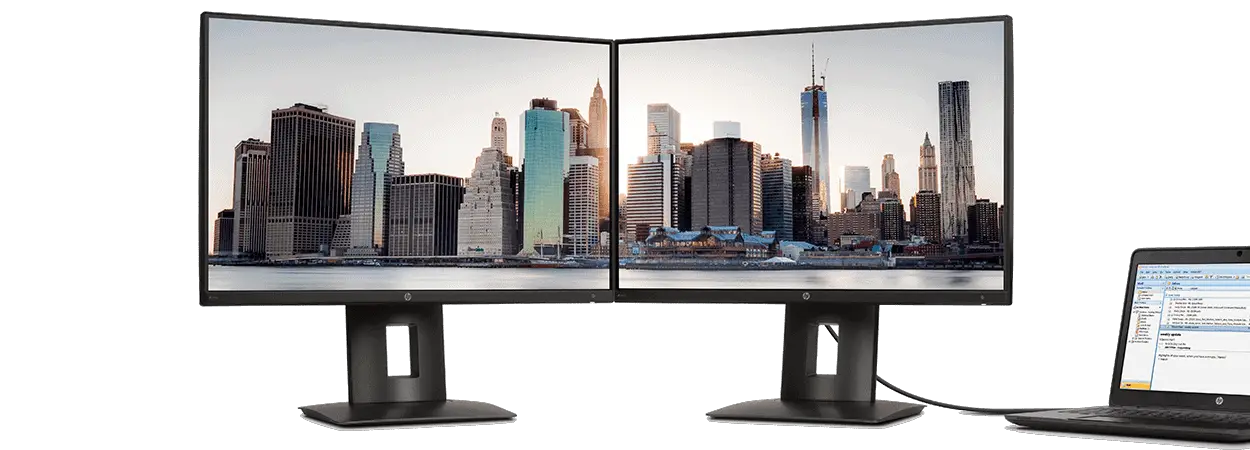When choosing a monitor setup, many consider two monitors connected side-by-side to increase productivity. But what about curved monitors? Are they suitable for dual monitor setups? While there is no one-size-fits-all answer when selecting the best dual monitor configuration, this article will explore the pros and cons of curved monitors in dual monitor setups to help you decide whether curved monitors are right.
Learn How to Change Mouse Direction on Dual Monitors in our article.

Are Curved Monitors Good for Dual Monitors?
Yes, curved dual monitors are beneficial because the extra curvature of a curved display implies an excellent user experience and enough space to view multiple documents side by side without compromising visibility or readability. However, in some cases, curved displays are limited in adjustability.
I do not use curved monitors because of the high price!
One of the advantages of using a curved monitor in a dual monitor setup is the extra screen estate it provides. The additional curvature of a curved display gives the user an increased field of view, allowing them to see more on the screen at once. This means that users can move windows between monitors and have enough space to view multiple documents side by side without compromising visibility or readability. The result is improved multitasking capabilities and more straightforward navigation between programs and documents. In addition, the subtle curvature helps reduce eye strain from long periods of computer use and provides a pleasant viewing experience.
On the other hand, curved monitors offer an immersive viewing experience but have some drawbacks when used in dual monitor setup configurations. For example, due to their shape, curved displays are limited in adjustability; it may be difficult or impossible to tilt or swivel them if needed. Additionally, since they are not flat, aligning two curved displays perfectly side by side may be difficult – something that could be annoying if you’re looking for an aesthetically pleasing setup. Finally, while most dual monitor configurations require two identical displays (in size and resolution), this isn’t necessary with a curved display due to its flexibility. However, this could lead to compatibility issues between different models from different brands, which could cause problems with color calibration or image quality.
Curved monitors are becoming increasingly popular in the world of technology, but they also come with unique advantages and disadvantages. In this article, we will explore the pros and cons of curved monitors and help you decide if they are right for you.
The most apparent advantage of curved monitors is a more immersive viewing experience. When used with the correct monitor settings, these displays can offer a panoramic field that wraps around your peripheral vision, making it feel like you are in the middle of what is happening onscreen. This effect is particularly beneficial for gamers or movie watchers as it creates a much more realistic experience than traditional flat screens can provide. Additionally, curved displays minimize reflections from ambient light sources, making them more accessible to the eyes.
On the other hand, one potential downside to curved monitors is their cost. The extra materials needed to create a near-circular display means these devices cost significantly more than their flat-screen counterparts. Furthermore, because of the curvature of these displays, not all wall mounts may be compatible, which could lead to additional costs when looking for mounting solutions. Even if wall-mounted solutions are available, many users find that these monitors take up a significant amount of space due to their design, so it might not be ideal if you have limited desk space.
Another potential disadvantage is how certain content looks on this type of monitor compared with traditional flat screens. Photos and videos typically look stunning on curved displays, but the text can sometimes appear distorted due to its curvature. This could be especially problematic for people who use their monitor primarily for work-related tasks such as coding or typing out large documents where having clear text is essential.
Finally, curved monitors provide an incredibly immersive viewing experience but must also be used in conjunction with settings designed explicitly for them. Otherwise, users may experience color distortions, discoloration, and incorrect gamma levels, drastically reducing overall picture quality. To ensure optimum results, users must familiarize themselves with all settings available to get the most out of their new device before making any adjustments.
Overall, there are plenty of benefits associated with using curved monitors, but it’s essential to consider all possible drawbacks before investing in one yourself. Curved displays deliver an incredible viewing experience, but when factoring in cost plus potentially limited compatibility issues or lackluster performance when displaying certain types of content, they might not always make sense, depending on how you plan on using them. Look into all aspects before deciding if purchasing a curved monitor is right!
Overall, whether or not a curved display is suitable for a dual monitor setup largely depends on what type of work environment you need it for. If you need your displays for video editing or graphic design purposes where color accuracy is critical, then a flat display may still be preferable; however, if you need more screen space and don’t mind sacrificing some adjustability, then a curved display could be ideal for your needs. It’s essential to weigh all factors before purchasing any new hardware, so research thoroughly before making any decisions!
- Facebook Ads to Get Followers! - December 27, 2024
- ClickUp vs. Slack - December 20, 2024
- Mastering E-Commerce Analytics: A Blueprint for Success





